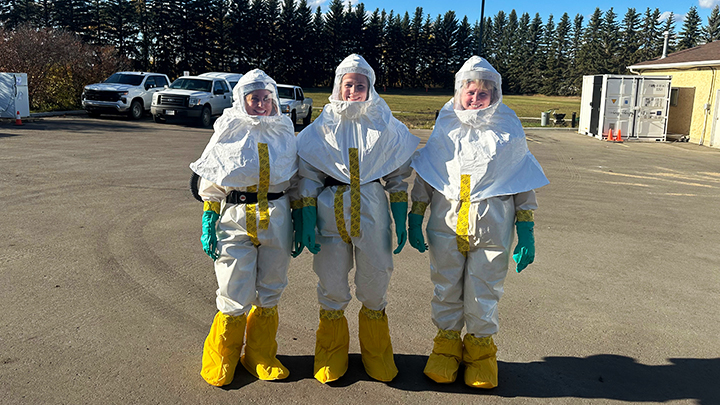
December 17, 2024

Employees at Redwater Health Centre participate in essential hazmat training, ensuring safety and preparedness in handling hazardous materials. Supplied.
Story by Lisa Laferriere
REDWATER — The Redwater Health Centre is a leader in emergency preparedness, recently completing the Alberta Health Services CBRN/HazMat First Receiver training with one of the highest attendances recorded in a single session in the North Zone.
Nine nursing staff from the centre completed this specialized training on Oct. 10, reinforcing the site’s commitment to safely in the handling of hazardous material incidents.
“This training is crucial for responding to emergencies and ensuring staff are prepared to respond to anything that comes through our doors,” says Karleen Gilker, site and seniors manager for the Redwater Health Centre.
The training program equips staff to handle exposure to hazardous materials, for both patient safety and staff protection during potentially life-threatening incidents. It focuses on chemical, biological, radiological, and nuclear (CBRN) hazards.
The course begins with online modules available through MyLearningLink. These 90-minute courses teach staff how to safeguard themselves against hazardous materials and respond effectively during emergencies.
Upon completion of online training, three-hour practical sessions take place on-site for acute and urgent care staff, including nurses, protective services and admitting staff. Rural sites often include local EMS personnel in this training. Physicians, clinical nurse educators and maintenance staff are also encouraged to participate.
“The more people who know how to respond to emergencies like this, the better. Especially at rural sites where it’s an all-hands-on-deck environment,” says Faro Taug, Emergency and Disaster Management officer. “There should always be trained personnel available, day and night.”
Taug highlights the importance of proper procedures, which include isolating affected patients and ensuring a thorough decontamination before entering the emergency space.
“When people get hurt and are contaminated, we can’t just bring them into the emergency department,” adds Taug. “For example, if someone is covered in bear spray or a similar substance, it poses a risk not only to them, but to other patients and staff as well.”
The training is not only about managing immediate hazards, but also about ongoing competency.
“Each healthcare site has unique infrastructure, making on-site training essential,” says Taug. “Practical training occurs every two years, with on-line refreshers in between.”
The variety of potential hazardous scenarios staff might face range from chemical spills to unusual contaminants used in different industry sectors.
Hands-on training, including practising in personal protective equipment (PPE), is also crucial.
“While the odds of facing certain chemicals are low, the potential impact is significant. Our training prepares staff for a wide range of situations,” Taug says.
Emergency management officers (EMOs) are committed to accommodate schedules for training sessions, giving all staff an opportunity to participate.
As part of their commitment, Gilker shares the importance of the training for staff.
“This training is crucial for us because it ensures our staff are prepared to handle emergencies safely,” says Gilker. “We strongly recommend that other sites take this training as well; it’s about protecting not just the contaminated patients, but everyone they come in contact with.”
Through ongoing training efforts, AHS aims to ensure that every healthcare facility in the North Zone is equipped to handle hazardous material incidents at any time.